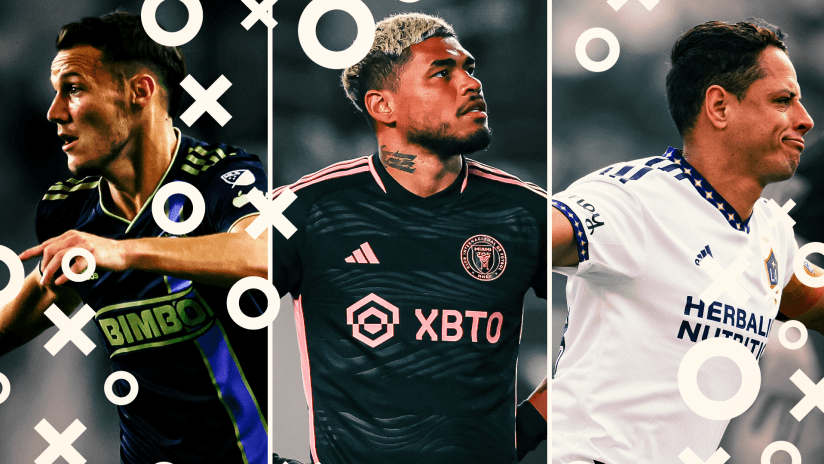Everybody has problems, right?
Yet through six MLS matchdays, some teams have bigger problems than others. So we’re digging into a handful of high-profile ones that need to be answered for teams around the league.
From personnel-related to tactical-oriented questions, there’s plenty to sink our teeth into. Let’s get to it.
What happened to the Union’s attack?
The Philadelphia Union’s attack lit MLS on fire last year, scoring a league-leading 72 goals as they fell narrowly shy of MLS Cup and Supporters’ Shield titles. They became the first team in league history to score 25 goals or more across a set of five consecutive home games. They also became the first team in league history to earn four wins by six or more goals. As I said, they lit stuff on fire in 2022.
It was always natural to expect some regression in 2023, at least in terms of those wild 6-0 scorelines. But when you peel back one more layer of the onion, you see a slightly more troubling situation for Philly: after averaging 1.77 expected goals in 2022, their average has dropped to 1.43 through six games in 2023, per American Soccer Analysis. And when you strip out their 4-1 win over Columbus Crew on MLS is Back weekend, Philadelphia’s average drops to 1.1 xG per game and their goals-per-game figure drops to 0.8.
It’s too early to get overly concerned about those numbers, but it’s clear the Union have taken a step back – despite having the same names around. Dániel Gazdag, Julián Carranza and Mikael Uhre are still the faces of this thing.
Competing in the 2023 Concacaf Champions League is likely hindering their firepower in MLS play right now. However, for a team that was generally tipped as a favorite for both MLS Cup and the Supporters’ Shield ahead of this season, it’s not unfair to expect Philly to advance deep in CCL playing while simultaneously excelling in MLS. LAFC, the other club in the Union’s stratosphere based on last year and preseason expectations, are largely thriving in both competitions.
Jim Curtin’s team will need to stop underperforming in attack if they’re truly going to truly threaten for trophies in 2023.
Will a healthy Chicharito fix the Galaxy?
Let’s run through some rather unpleasant stats, shall we? So far this year, the LA Galaxy are:
- Averaging 0.6 points per game, which is tied for 25th in MLS
- Currently 12th in the Western Conference standings
- Sitting on a negative-3 goal differential
They’re struggling, folks.
The underlying numbers like the Galaxy significantly more than the boxscore stats do, but there are clear problems with this team. They’ve looked indecisive and have been inefficient in the final third for the vast majority of their five games. Riqui Puig has been excellent in midfield – based on American Soccer Analysis’ goals-added metric, he’s been one of the 20 most valuable players in MLS this year – but once the ball arrives in the attack, things freeze. Or, if they don’t freeze, they don’t move as quickly as they should to create the best possible chance.
Will Chicharito, who has missed the entire season with a hamstring injury but appears close to returning this weekend, help solve things? Potentially. The Galaxy have created more chances than the average MLS team and could benefit from Chicharito’s expert movement in the box. Still, LA’s biggest issue right now is their lack of quality wing play. All three of their primary wingers – Tyler Boyd, Memo Rodríguez and Efraín Álvarez – have been far below average in 2023, both based on ASA’s goals added metric and, well, the human eyeball. Douglas Costa? The DP winger has only just returned from a calf injury and based on last year’s form, he doesn’t seem likely to single-handedly fix the problems.
To climb up the Western Conference table, the Galaxy need a serious lift in attack. Chicharito, boxscore production from Puig, Dejan Joveljić truly getting off the mark and a winger signing or two before the Primary Transfer Window closes on April 24… plenty could do the trick. This is fixable.
What’s wrong with Inter Miami?
After starting the season with two wins, one over CF Montréal and the other over the Philadelphia Union, Phil Neville’s squad has lost four straight games.
What’s wrong with this team? Well, the truth is, quite a bit.
First, the injury to Gregore in central midfield has put Miami in a difficult position. Gregore, who was great last year alongside compatriot Jean Mota, went down against New York City FC on Matchday 3 (foot injury) and will likely be out until September. Unfortunately, Miami lack a like-for-like replacement for their captain in a hugely important area. They're still experimenting with how to best replace the Brazilian midfielder, using some combination of Bryce Duke and Victor Ulloa. That’s a situation worth monitoring.
The Gregore injury hurts. The fact that striker Leo Campana hasn’t played yet this season due to a calf injury hurts, too. He was their second-leading scorer in 2022, behind since-retired Gonzalo Higuaín. It’s extremely rare for any team in MLS to overcome injuries to multiple key players at the same time.
Then, there’s the Josef Martínez problem. The Atlanta United legend, who arrived in the offseason after a contract buyout, is yet to score for his new club and is averaging just 0.21 xG per 90 minutes, according to FBref. That’s a dangerously-low xG number for any striker. Martinez needs service and he needs a solid midfield platform behind him, but he’s not getting either of those things right now in Miami.
Without Gregore and Campana, and with Josef chasing his electric days of old, Miami have to prove they’re a capable team. They haven’t really looked like one over the last month.
How will Brian Schmetzer deal with his “champagne problem” in attack?
We’ve got ourselves a good problem, folks.
A couple of weeks ago, with star striker Raúl Ruidíaz away on international duty (Peru) and overqualified backup striker Héber recovering from a minor injury, Seattle Sounders manager Brian Schmetzer moved Jordan Morris up top to play as a striker against Sporting Kansas City. Léo Chú moved into the starting lineup on the left wing to fill the hole left by Morris. Four goals for Morris, four assists for Chú and three points for the Sounders later, and Schmetzer used that same attacking combination against the LA Galaxy last Saturday. Morris and Chú both scored, and the Sounders picked up three more points on the road.
So as Seattle look ahead to the next stretch of the season, how is Schmetzer going to set up his attacking personnel? You can’t ditch this Morris/Chú approach, right? But what are you supposed to do, leave Ruidíaz on the bench? What about Cristian Roldan at right winger, a versatile player who could drop into midfield?
It’s a delightfully difficult, depth-centric situation with Morris surging into the Golden Boot presented by Audi lead and Chú coming good on his U22 Initiative roster tag. As the Sounders push for silverware on multiple fronts, having multiple different looks to toggle between when they’re up against various kinds of opponents will only be a good thing. The most important thing for Schmetzer will be picking the right moments to use one look versus the other.
Can Oscar Pareja put the pieces in the right spots?
After making several big moves during the offseason and tapping into different roster-building mechanisms, it’s been a mostly anti-climactic start to 2023 for Orlando City SC. Oscar Pareja’s team is currently sitting seventh in the Eastern Conference table with eight points through six games. They’ve won just one of their last seven matches across both MLS and CCL play.
For Orlando to pick up their points-earning tempo, Pareja must maximize the play of new DP attacker Martín Ojeda. Ojeda has played in two different positions so far this year: he started the season as a No. 10 in Pareja’s fluid 4-2-3-1 shape and, more recently, has played out to the right side of that attacking line of three. Overall, Ojeda looks more comfortable on the right side, which isn’t a big surprise given he played for long stretches as a winger with Godoy Cruz in Argentina.
The trouble for Pareja, though, is it’s impossible to play Ojeda, Iván Angulo and Facundo Torres all on the wings at the same time while Mauricio Pereyra sits next to César Araújo in midfield. There’s simply not enough defensive structure in that group. Pareja will have to compromise somewhere to get the best complement of players thriving together (my vote would be a 3-4-3 possession shape with Torres and Ojeda in the halfspaces and either Pereyra or a more defensive-minded midfielder next to Araujo depending on the opponent). There's also the matter of figuring out their go-to No. 9, whether that's Ercan Kara (DP), Ramiro Enrique (U22 Initiative) or Duncan McGuire (SuperDraft).
Ojeda has two goals and some nice underlying numbers so far this year. If he can truly settle in on the right of Orlando City’s attack, Pareja’s team will be much more threatening as 2023 continues.


















